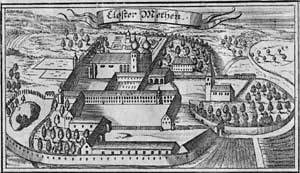Related Research Articles
Heinrich Roth was a missionary and pioneering Sanskrit scholar.

Christoph Scheiner was a Jesuit priest, physicist and astronomer in Ingolstadt.

Mariawald Abbey was a monastery of the Trappists, located above the village of Heimbach, in the district of Düren in the Eifel, in the forests around Kermeter, North Rhine-Westphalia, Germany. In September 2018, the last remaining monks left Mariawald Abbey and the monastery is currently up for sale.
Fultenbach Abbey was a Benedictine monastery located at Holzheim in Bavaria, Germany.

Frauenzell Abbey was a Benedictine monastery situated in Frauenzell, which is part of Brennberg in Bavaria, Germany.

Metten Abbey, or St. Michael's Abbey at Metten is a house of the Benedictine Order in Metten near Deggendorf, situated between the fringes of the Bavarian Forest and the valley of the Danube, in Bavaria in Germany.

Oberalteich Abbey was a Benedictine monastery in Bogen, Bavaria, Germany.

Garsten Abbey is a former Benedictine monastery located in Garsten near Steyr in Upper Austria. Since 1851, the former monastery buildings have accommodated a prison.

Wettenhausen Abbey was an Imperial Abbey of Augustinian Canons until its secularization in 1802–1803. Being one of the 40-odd self-ruling Imperial Abbeys of the Holy Roman Empire, Wettenhaussen Abbey was a virtually independent state. Its abbot had seat and voice in the Imperial Diet, where he sat on the Bench of the Prelates of Swabia. At the time of secularization, the Abbey's territory covered 56 square kilometers and it had about 5,400 subjects.

Elchingen Abbey was a Benedictine monastery in Oberelchingen in Bavaria, Germany, in the diocese of Augsburg.

Aldersbach Abbey is a former Cistercian monastery in the community of Aldersbach in the district of Passau in the valley of the Vils, Lower Bavaria, Germany.

Schuttern Abbey was a Benedictine monastery in Schuttern, Baden-Württemberg, Germany.
Roggenburg Abbey is a Premonstratensian canonry in Roggenburg near Neu-Ulm, Bavaria, in operation between 1126 and 1802, and again from its re-foundation in 1986. Since 1992 it has been a dependent priory of Windberg Abbey in Lower Bavaria. The monastery manages a training centre and a museum, and is widely known for its almost unchanged Baroque building and the organ concerts that are held in the church.

Schöntal Abbey is a former Cistercian abbey in Schöntal in the district of Hohenlohe, Baden-Württemberg, Germany. It is famous as one of the most impressive pieces of Baroque architecture in northern Württemberg and is now used by the Diocese of Rottenburg-Stuttgart as a retreat and training centre.

Grünau Charterhouse is a former Carthusian monastery, or charterhouse, in Schollbrunn in Bavaria, Germany. It was the first Carthusian monastery in Franconia and in today's Bavaria.

Engelgarten Charterhouse or Würzburg Charterhouse is a former Carthusian monastery, or charterhouse, in Würzburg in Bavaria, Germany.

Altenberg Abbey is a former Cistercian monastery in Altenberg, now a part of the municipality of Odenthal in the Bergisches Land, North Rhine-Westphalia, Germany.

Altzella Abbey, also Altzelle Abbey, is a former Cistercian monastery near Nossen in Saxony, Germany. The former abbey contains the tombs of the Wettin margraves of Meissen from 1190 to 1381.

The Collegiate Church of Saints Philip and James, Altötting, with the associated college or community of secular canons, was founded in about 1228 in Altötting, Bavaria, southern Germany.

Marienstatt Abbey is a Cistercian monastery and a pilgrimage site in Streithausen, Westerwaldkreis, Rhineland-Palatinate, in the Nister valley near Hachenburg.
References
- ↑ Klöster in Bayern: Echenbrunn
- ↑ Johann Bauhofer, "Die ehemalige Benediktiner-Abtei Echenbrunn" in Jahrbuch des Historischen Vereins Dillingen, vol. 9 (1896), pp. 127–143